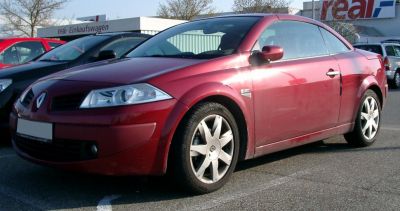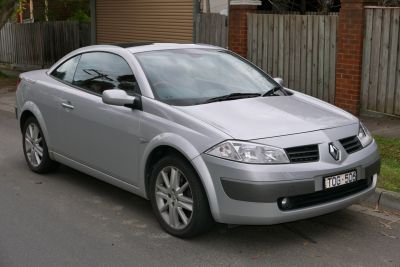 2011 Peugeot 308 CC I (Phase II, 2011) Dimensions, Size & Specs
2011 Peugeot 308 CC I (Phase II, 2011) Dimensions, Size & SpecsMeasurements of the 2011 Peugeot 308 CC I, engineered for optimal performance and comfort
| Dimensions | |
|---|---|
| Length: | 4400-4440 mm173.2-174.8 in14.4-14.6 ft |
| Width: | 1817-1872 mm71.5-73.7 in6.0-6.1 ft |
| Height: | 1427 mm56.2 in4.7 ft |
| Trunk Capacity: | 226 liter8.0 cu ft |
| Trunk Capacity (Max): | 403 liter14.2 cu ft |
| Weight Specifications | |
| Curb Weight: | 1515-1625 kg3340-3583 lbs |
| Maximal permitted Weight: | 1885-2050 kg4156-4519 lbs |
| Tire Specifications | |
| Rims Sizes: |
|
| Tire Sizes: |
|
The Peugeot 308 CC I Phase II, produced between 2011 and 2015, is a stylish cabriolet that offers a blend of compact dimensions and practical features. Measuring between 4400 mm and 4440 mm (173.2 to 174.8 inches) in length, the vehicle maintains a balanced and sleek profile suitable for urban and leisure driving. The width ranges from 1817 mm to 1872 mm (71.5 to 73.7 inches), providing a stable stance on the road while accommodating a comfortable cabin space. The height hovers around 1426 to 1427 mm (56.1 inches), reflecting its low-slung, sporty cabriolet design.
In terms of weight, the 308 CC Phase II varies from 1515 kg to 1625 kg (3340 to 3583 lbs) in curb weight, with a maximum permitted weight between 1885 kg and 2050 kg (4157 to 4519 lbs). This weight classification contributes to its agile handling and responsive driving experience. The car is equipped with a selection of rim sizes—16, 17, and 18 inches—paired with tire dimensions of 225/45 R17, 225/40 R18, 215/55 R16, and 205/55 R16 variants, ensuring a tailored balance between comfort and sportiness.
Practicality is noticeable with a standard luggage capacity of 226 liters (approximately 8.0 cubic feet), which expands to 403 liters (14.2 cubic feet) when the rear seats are folded down, offering flexibility for longer trips or additional cargo. The Peugeot 308 CC I Phase II represents a harmonious mix of design, performance, and usability, making it a compelling choice in the compact cabriolet segment.
Discover the standout features that make the 2011 Peugeot 308 CC I a leader in its class
Have a question? Please check our knowledgebase first.
The Peugeot 308 CC I (Phase II, 2011) features a length ranging from 4400 mm to 4440 mm (173.2 to 174.8 inches), a width between 1817 mm and 1872 mm (71.5 to 73.7 inches), and a height around 1426 to 1427 mm (56.1 inches). These dimensions position it as a compact yet spacious convertible, carefully designed to balance sporty aesthetics with practical use. Its width varies depending on the specific trim and optional equipment, which may include different wheel sizes affecting the overall wheelbase and stance. The height remains quite low, in line with typical cabriolet design to enhance aerodynamic efficiency and styling.
The curb weight for the Peugeot 308 CC I (Phase II, 2011) ranges between 1515 kg and 1625 kg (approx. 3340 to 3584 lbs), depending on the trim level, engine, and optional features. The maximum weight, which includes passengers and cargo, ranges from 1885 kg to 2050 kg (around 4157 to 4519 lbs). The variance in weight depends on added equipment such as wheel sizes (16, 17, or 18 inches) and safety features. The relatively moderate weight is balanced for optimized handling and performance, offering a good mix of stability and agility for a cabriolet of its class.
The Peugeot 308 CC I provides a practical luggage capacity of 226 liters (about 7.98 cubic feet) with the rear seats in their upright position. This is somewhat limited, as is typical with cabriolets due to design constraints from the retractable hardtop mechanism. When the rear seats are folded down, the luggage space expands to 403 liters (approximately 14.23 cubic feet), significantly enhancing cargo flexibility. This allows for larger items to be transported, making it more adaptable for weekend trips or light luggage hauling despite being a compact convertible.
Yes, the Peugeot 308 CC I generally fits comfortably in a standard garage. Given its length of up to 4440 mm (174.8 inches) and width maxing out around 1872 mm (73.7 inches), it is well within the dimensions of most garages designed to accommodate regular passenger vehicles. The height of roughly 1427 mm (56.1 inches) also contributes to easy parking indoors. However, it is essential to allow some additional clearance for mirror width and easy ingress and egress. Owners with standard single-car garages should have no difficulty storing this cabriolet safely indoors.
Compared to the predecessor Peugeot 308 CC I Phase I, the Phase II (2011) model features slight dimensional refinements aimed at enhancing aesthetics and comfort. Typically, the Phase II model saw marginal increases in width and length, improving cabin space and exterior presence. Where the Phase I model measured slightly less in width and length, the Phase II's 4400-4440 mm length and 1817-1872 mm width provide better road stability and a more assertive stance. Height remained consistent around 1426 mm, preserving the sleek cabriolet profile. These changes contribute to a more modern design, improved ergonomics, and a refined driving experience.
The Peugeot 308 CC I (Phase II, 2011) competes in the compact convertible segment alongside cars like the Volkswagen EOS and Audi A3 Cabriolet. Dimensionally, the 308 CC is very competitive: its length around 4.4 meters (174 inches) places it in the mid-range for competitors, while its width, peaking near 1.87 meters (74 inches), offers slightly more shoulder room compared to some rivals. Luggage capacity at up to 403 liters (rear seats folded) is respectable but generally lower than some hardtop convertibles with larger trunks. Overall, the 308 CC offers a balanced combination of size for urban maneuvering and comfortable space for longer drives when compared to similar cabriolets.
The Peugeot 308 CC I (Phase II, 2011) offers multiple rim size options: 16-inch, 17-inch, and 18-inch variants. Tires include sizes such as 225/45 R17, 225/40 R18, 215/55 R16, 215/55 R16 V, 225/45 R17 V, and 205/55 R16 V. Larger wheels typically increase the overall width and slightly elevate the stance, which enhances handling and road grip but may affect ride comfort. The smallest rims, 16 inches, help improve ride softness and reduce unsprung mass for efficiency. While the rim size does not drastically change the core vehicle dimensions, the tire profile and width can influence track width, ground clearance, and the car’s external width by a few millimeters.
The height of the Peugeot 308 CC I (Phase II, 2011) is approximately 1426 to 1427 mm (about 56.1 inches). This relatively low height helps maintain a sporty and aerodynamic profile typical of cabriolets. While this low roofline reduces overall headroom compared to hatchback or sedan models, the 308 CC is designed to provide adequate comfort for front occupants with supportive seating. The low height also benefits aerodynamic efficiency, contributing to better fuel economy and handling at speed. Rear passenger headroom is more limited, typical for a two-door convertible design.
The production period for the Peugeot 308 CC I (Phase II) from 2011 to 2015 represents a mid-cycle facelift that brought updated styling and technology enhancements over the initial launch. This phase II model features slight exterior refreshes such as redesigned front and rear bumpers, updated lighting elements, and subtle interior improvements focused on modernizing controls and materials. Technologically, Peugeot incorporated improved infotainment systems, upgraded safety features, and tweaks for better driving dynamics. These updates helped the 308 CC remain competitive in the convertible segment until production ended in 2015.
With a length of approximately 4400 to 4440 mm (173.2 to 174.8 inches) and a width between 1817 and 1872 mm (71.5 to 73.7 inches), the Peugeot 308 CC I (Phase II, 2011) is well suited for urban environments with moderate space constraints. Its compact length allows for easier parallel parking and tighter turns in city streets compared to larger convertibles or sedans, while the width gives it a stable road presence but may require some care in narrow parking spaces. Despite its convertible nature and slightly wider stance due to wheel options, the 308 CC balances driver comfort and maneuverability effectively, making it a practical choice for city driving and weekend trips alike.
Discover similar sized cars.

| Model Year: | 2006 |
|---|---|
| Length: | 4355 mm171.5 in |
| Width: | 2026 mm79.8 in |
| Height: | 1404 mm55.3 in |

| Model Year: | 2003 |
|---|---|
| Length: | 4355 mm171.5 in |
| Width: | 2026 mm79.8 in |
| Height: | 1404 mm55.3 in |
